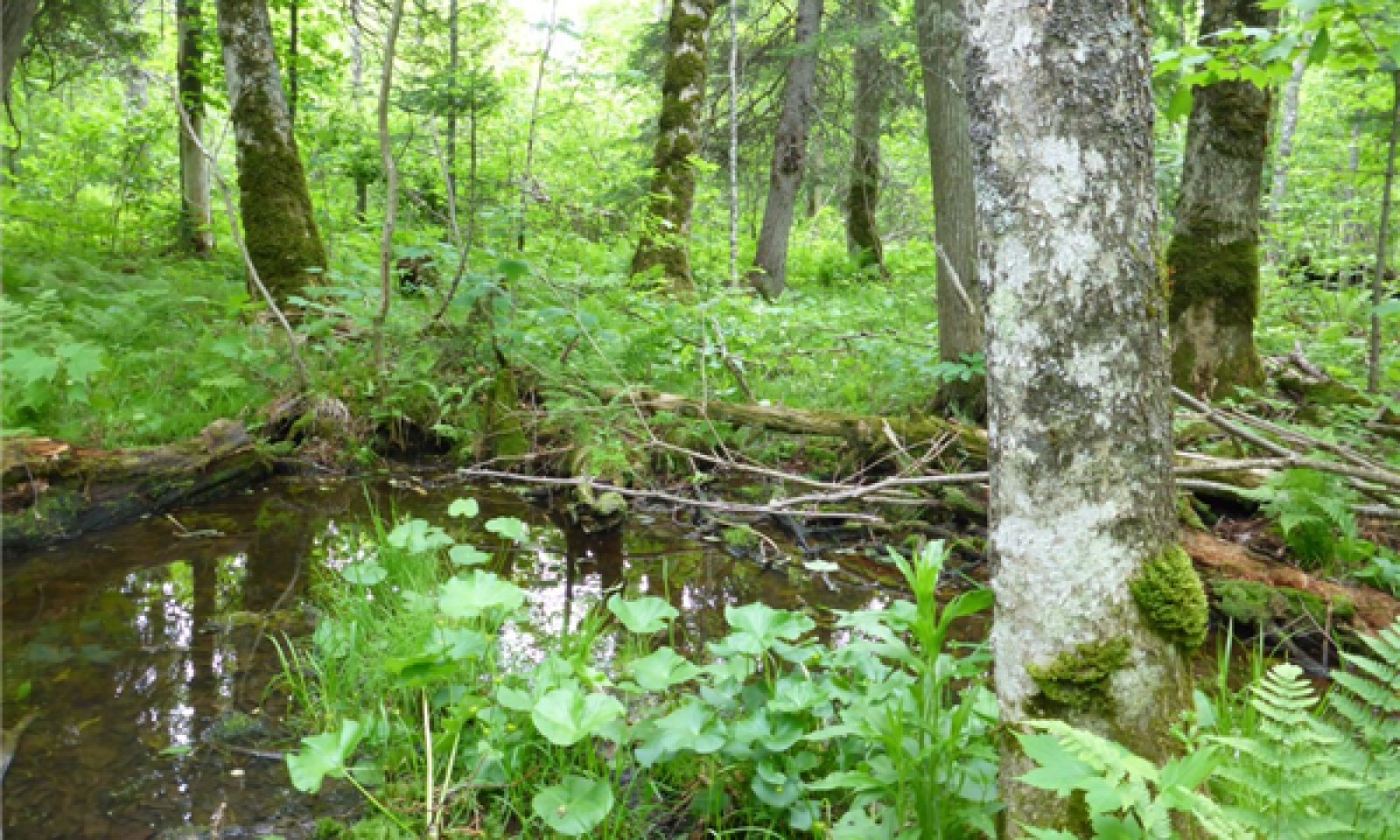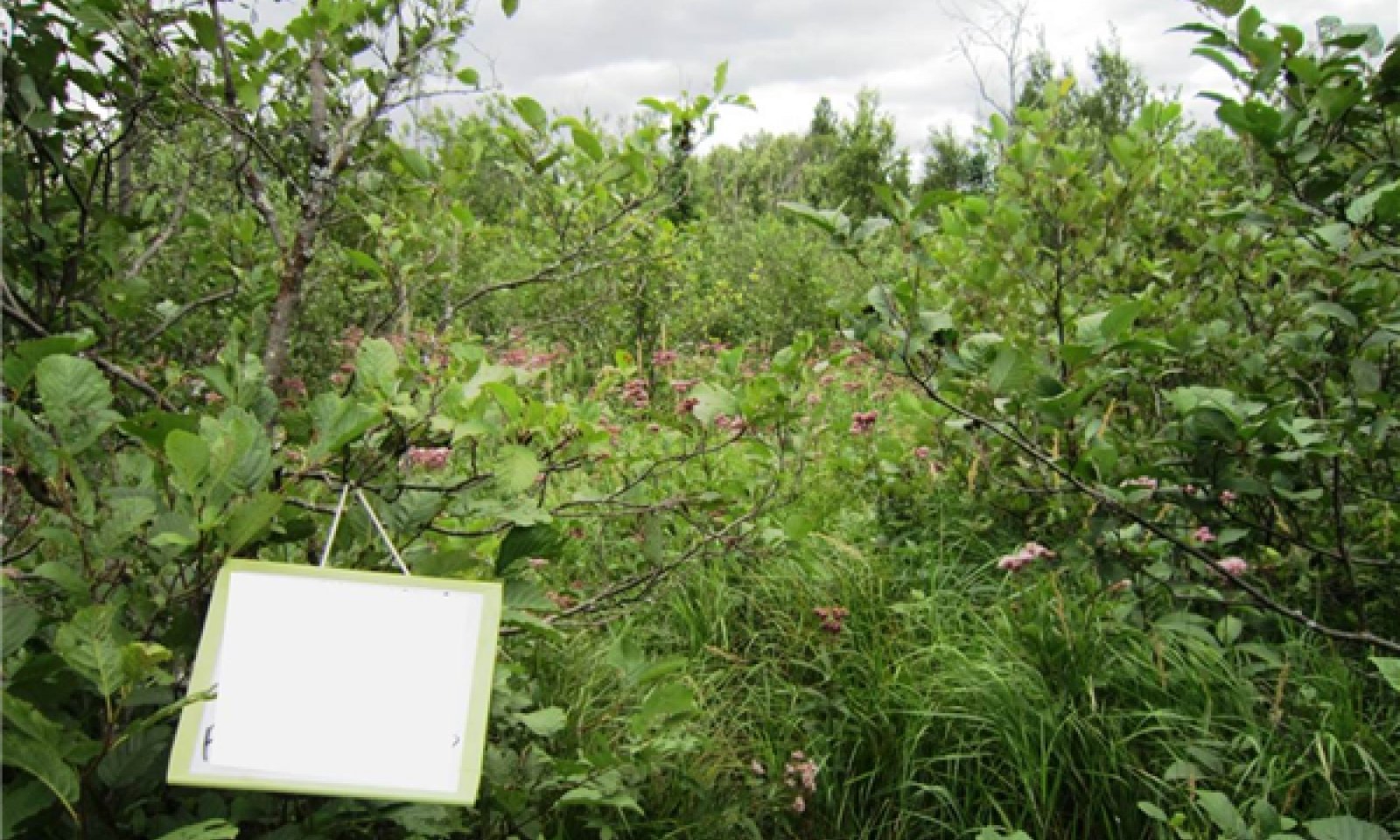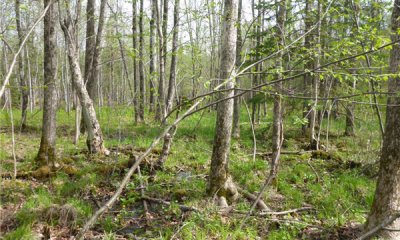
Depressional Wet Hardwood Forest
Scenario model
Current ecosystem state
Select a state
Management practices/drivers
Select a transition or restoration pathway
-
Transition T1A
Site becomes flooded
More details -
Transition T1B
Tree canopy removed
More details -
Transition T2A
Reduced water level
More details -
Restoration pathway R3A
Forest succession
More details -
Transition T3A
Increase in water levels
More details -
No transition or restoration pathway between the selected states has been described
Target ecosystem state
Select a state
State 1
Reference State - Mature Forest




Description
Community phases within the Reference State are related to scattered small and moderate sized canopy openings from dead and/or windthrown trees. Windthrown trees are primarily dominant, above the canopy, and more exposed to wind events. These trees, with shallow root systems, were likely previously weakened by either excessive drought or ponding, leaving them open to attack by forest pests (MN DNR, 2014). Standing dead trees from excessive ponding or drought may also provide these canopy openings. An estimated rotation of such events is 110 years (MN DNR, 2014; MN DNR, 2005). This produced a patchwork of young and mature forests, all dominated by black ash. Black ash is fairly shade tolerant as a seedling, and is often the only advanced regeneration present in the understory, and thus it tends to replace itself in many situations (Gucker, 2005; Erdmann et al., 1987). Black ash is also a long-lived species and can live to over 250 years old (Gucker, 2005). Without larger openings, structure and composition of mature stands can be nearly perpetual, and gradually regenerate new trees via small, one to many tree sized openings. As a result of rather frequent, small scale openings, stands do not often become old growth (i.e., greater than 135 years; MN DNR, 2014). But in cases where they do, canopy structure is complex, and generally includes a component of long-lived and more shade tolerant white spruce and balsam fir.
Northern white cedar and yellow birch often find their primary rooting substrate on downed woody debris associated with these openings. Both species regenerate well on mossy, rotting wood (i.e., nurse logs) that have consistent moisture (Smith, 2008 Erdmann, 1990; Johnston, 1990). Eventually, initial rooting media from downed woody debris can leave roots exposed to air and result in poorly formed trees. Northern white cedar can also regenerate by vegetation reproduction. These stems usually are developed from fallen trees and root from branches that come in contact with moist rooting media and are extremely shade tolerant (Erdmann, 1990). Hummocks and micro depressions resulting from windthrown trees are an important component of the Reference State. This variability in microsites provides opportunity for obligate wetland species in ponded micro depressions and upland species on the drier hummocks.
Today, much of the distribution of this ecological site is in community phases very similar those in the Reference State.
Submodel
Description
The Flooded State develops as a result of dammed or blocked waterways. Flooding is caused primarily by either beaver activity or development associated with road building. Only drainageway landforms are affected, and isolated depressions do not go through this state. Sites that have blocked water drainage from roads may become perpetual open water wetlands. In natural settings, the Flooded State can last for many years, but it ultimately depends on maintenance of high quality habitat conditions for beaver to proliferate. Once a site is abandoned, dams will gradually decline and ultimately drain, thereby beginning the transition to the Non-Forested State.
Beaver populations in North America were drastically reduced by broad scale fur trapping during the Colonial time period, into the 1800s (Mitsch and Gosselink, 2007). As a result, natural conversion of these sites to the Flooded State may be less common today than it was prior to European settlement.
Submodel
State 3
Non-Forested State



Description
Sites can transition to this state by relatively sudden and complete loss of the tree canopy, thereby losing the transpiration of water from trees needed to keep water tables at bay and allow tree species to continually proliferate. This can happen as a result of intensive logging, forest pests, or general forest decline. This state will likely become common in the MLRA if the invasion of the exotic emerald ash borer (Agrilus planipennis) beetle is not halted (Slesak et al., 2014; Palik et al., 2012).
Sites can also transition to this state from the Flooded State, following drainage of backed up water from beaver activity or road building. Initially, sites are wet meadows dominated by graminoids (e.g., bluejoint and sedges), eventually becoming invaded by wetland shrubs depending on level of ponding and soil saturation. These sites may have different soil characteristics depending on the extent and depth of sedimentation, which is largely dependent on how long the site was dammed (Naiman et al., 2005)and is also related to nearby land use and landscape-level soil geomorphology. More research is needed on how soil properties change following long term flooding from blocked hydrology.
Other than a few scattered trees, these sites do not seem to regenerate trees well. Transition to the Reference State is relatively unknown, and will require long term ecological succession over the course of many decades. There is limited evidence that these communities succeed to a forested structure within a reasonable time frame (SNF, unpublished report b). Non-forested wetland conditions may persist for decades, and even centuries (Naiman et al., 2005; Terwilliger and Pastor, 1999). Viability of black ash seeds is only 8 years (Wright and Rauscher, 1990), so seeds are probably at least initially extirpated from the site. And since most sites are small and isolated, there may not be a reliable seed source nearby. The loss of important mycorrhizal relationships may also impede succession of forest trees. It has been shown that long-term flooding kills mycorrhizae that form essential relationships with tree species in other types of forested wetlands in the region, and recolonization following draining may be inhibited (Anderson and Fischer, 2015; Terwilliger and Pastor, 1999), which may be the case in this ecological site as well. All of this, in combination with extreme competition with resident vegetation, make succession to a forested state difficult.
Submodel
Mechanism
Flooding, backed up water from beaver dam or road bed.
Mechanism
Removal of tree canopy resulting in loss of transpiration and elevated water levels.
Mechanism
Long term forest succession.
Model keys
Briefcase
Add ecological sites and Major Land Resource Areas to your briefcase by clicking on the briefcase (![]() ) icon wherever it occurs. Drag and drop items to reorder. Cookies are used to store briefcase items between browsing sessions. Because of this, the number of items that can be added to your briefcase is limited, and briefcase items added on one device and browser cannot be accessed from another device or browser. Users who do not wish to place cookies on their devices should not use the briefcase tool. Briefcase cookies serve no other purpose than described here and are deleted whenever browsing history is cleared.
) icon wherever it occurs. Drag and drop items to reorder. Cookies are used to store briefcase items between browsing sessions. Because of this, the number of items that can be added to your briefcase is limited, and briefcase items added on one device and browser cannot be accessed from another device or browser. Users who do not wish to place cookies on their devices should not use the briefcase tool. Briefcase cookies serve no other purpose than described here and are deleted whenever browsing history is cleared.
Ecological sites
Major Land Resource Areas
The Ecosystem Dynamics Interpretive Tool is an information system framework developed by the USDA-ARS Jornada Experimental Range, USDA Natural Resources Conservation Service, and New Mexico State University.



